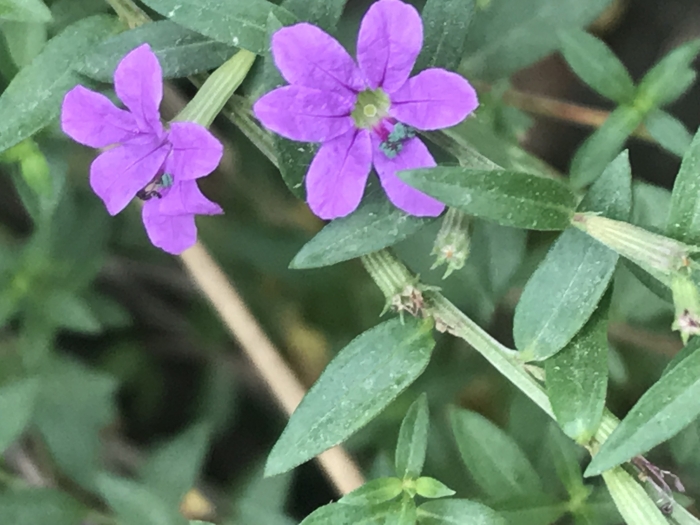Winged Loosestrife
(Lythrum alatum)
Winged Loosestrife (Lythrum alatum)
/
/

Adriana Nelly Correa Sandoval
CC BY 4.0
Image By:
Adriana Nelly Correa Sandoval
Recorded By:
Copyright:
CC BY 4.0
Copyright Notice:
Photo by: Adriana Nelly Correa Sandoval | License Type: CC BY 4.0 | License URL: http://creativecommons.org/licenses/by/4.0/ | Rights Holder: Adriana Nelly Correa Sandoval | Publisher: iNaturalist | Date Created: 2019-04-29T18:59:19Z |

















































Estimated Native Range
Summary
Lythrum alatum, commonly known as Winged Loosestrife, is a deciduous perennial herb native to a variety of habitats including moist prairies, wet meadows, stream banks, and marsh edges in the Central and Eastern USA. It typically grows to about 1 meter tall and is characterized by its winged stems and upright, branching form. The flowers, which bloom from June to September, are borne singly or in pairs in the axils of the upper leaves. Each flower has six rose-pink petals with a distinctive magenta central vein, measuring about 5 millimeters in length and 2 millimeters in width. The plant’s six stamens feature pink filaments and purple anthers, while the stigma is white and the style is green, adding to the visual interest of the blooms.
Winged Loosestrife is valued for its attractive flowers and ability to attract pollinators such as bees and butterflies, making it a beneficial addition to wildlife gardens. It is also used for naturalizing in wet areas and can be a component of rain gardens due to its tolerance of wet conditions. In cultivation, it thrives in part shade to full sun and prefers medium to high moisture levels in soils with slow or wet drainage. While it is not aggressive like other Lythrum species, such as the invasive Purple Loosestrife (Lythrum salicaria), gardeners should still monitor its spread to ensure it does not become too dominant in a planting.CC BY-SA 4.0
Winged Loosestrife is valued for its attractive flowers and ability to attract pollinators such as bees and butterflies, making it a beneficial addition to wildlife gardens. It is also used for naturalizing in wet areas and can be a component of rain gardens due to its tolerance of wet conditions. In cultivation, it thrives in part shade to full sun and prefers medium to high moisture levels in soils with slow or wet drainage. While it is not aggressive like other Lythrum species, such as the invasive Purple Loosestrife (Lythrum salicaria), gardeners should still monitor its spread to ensure it does not become too dominant in a planting.CC BY-SA 4.0
Plant Description
- Plant Type: Herb
- Height: 2-4 feet
- Width: 1-3 feet
- Growth Rate: Rapid
- Flower Color: Pink, Purple
- Flowering Season: Summer
- Leaf Retention: Deciduous
Growth Requirements
- Sun: Full Sun, Part Shade
- Water: Medium, High
- Drainage: Slow
Common Uses
Bee Garden, Bird Garden, Butterfly Garden, Deer Resistant, Hummingbird Garden, Low Maintenance, Showy Flowers, Water Garden
Natural Habitat
Moist prairies, wet meadows, stream banks, and marsh edges
Other Names
Common Names: Winged Lythrum , Wing-Angle Loosestrife , Salicaire Ailée
Scientific Names: Lythrum alatum , Lythrum alatum var. pumilum , Lythrum alatum var. breviflorum
GBIF Accepted Name: Lythrum alatum Pursh